Children’s Pictorial Expression of Plant Life and Its Connection with School-Based Greenness
Abstract
1. Introduction
- To examine the pictorial content and the use of colour in the drawings that children in the sample depict to express their knowledge about plant life; and
- To relate the differences that the two educational centres included in the study show in terms of accessibility to green areas with the pictorial content and the use of colour in the depictions of the plant world that the children in the sample draw.
2. Materials and Methods
2.1. Description of the Educational Centres Involved in the Study
2.2. The Sample of Drawings Studied
2.3. Description of the Pictorial Task
2.4. Variables and Statistical Procedures
- (a)
- Independent variables: educational centre (school A and school B) and sex.
- (b)
- Dependent variables: related to the pictorial content and the colour used in the drawings, as follows:
- Number of pictorial elements identified in each of the drawings composing the sample. It is understood that a pictorial element is the graphic representation of a drawn entity that presents a certain level of independence with respect to other parts of the drawing. The pictorial elements can be realistic representations of objects and living beings, for example, a flower or a tree, but they can also be abstract representations, such as decorative patterns. The researcher who carried out the meeting with the children also encoded the drawings, based on the information that she had collected regarding the meaning of the pictorial content of the drawings in the interviews. Notably, this same criterion has been used in previous research [23].
- Number of different pictorial elements in each of the following five categories:
- ○
- Plants: plant type (flowers, grass, vegetables, fruit, trees, etc.);
- ○
- Morphological elements of the plant world: singular parts of plants, for example, leaves, seeds, roots or fruits;
- ○
- Abiotic elements: sun, clouds, rainbows, rain, soil, mountains, etc.;
- ○
- Other living things: vertebrate animals, invertebrates, fungi, mushrooms, etc.; and
- ○
- Elements unrelated to the plant world: the representation of entities without or little relationship with the plant world, for example, balls, houses, roads, trucks, etc.
- Total area coloured: quantification of the coloured area in each drawing, taking values between 0 and 623.7 (Din A4).
- Area coloured with each of the 12 colours that the girls and boys who participated in the pictorial activity had available to them at the time of the interview.
2.5. Ethical Declaration
3. Results
3.1. Results of the Study for the Sample as a Whole
3.2. Results of the Study Related to the Comparison Between the Drawings by Children in School A and School B
4. Discussion and Conclusions
Author Contributions
Funding
Institutional Review Board Statement
Informed Consent Statement
Data Availability Statement
Conflicts of Interest
Appendix A
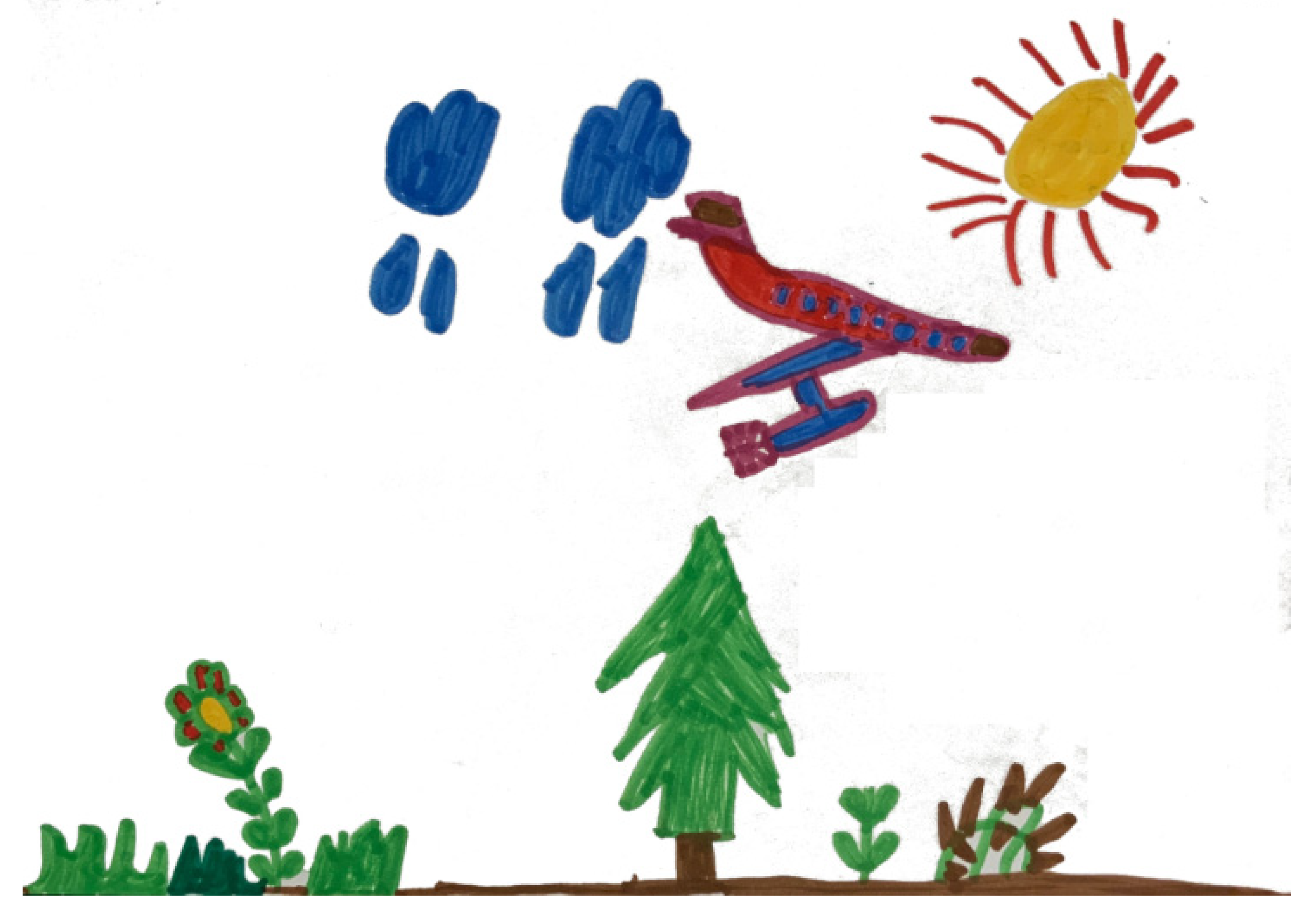
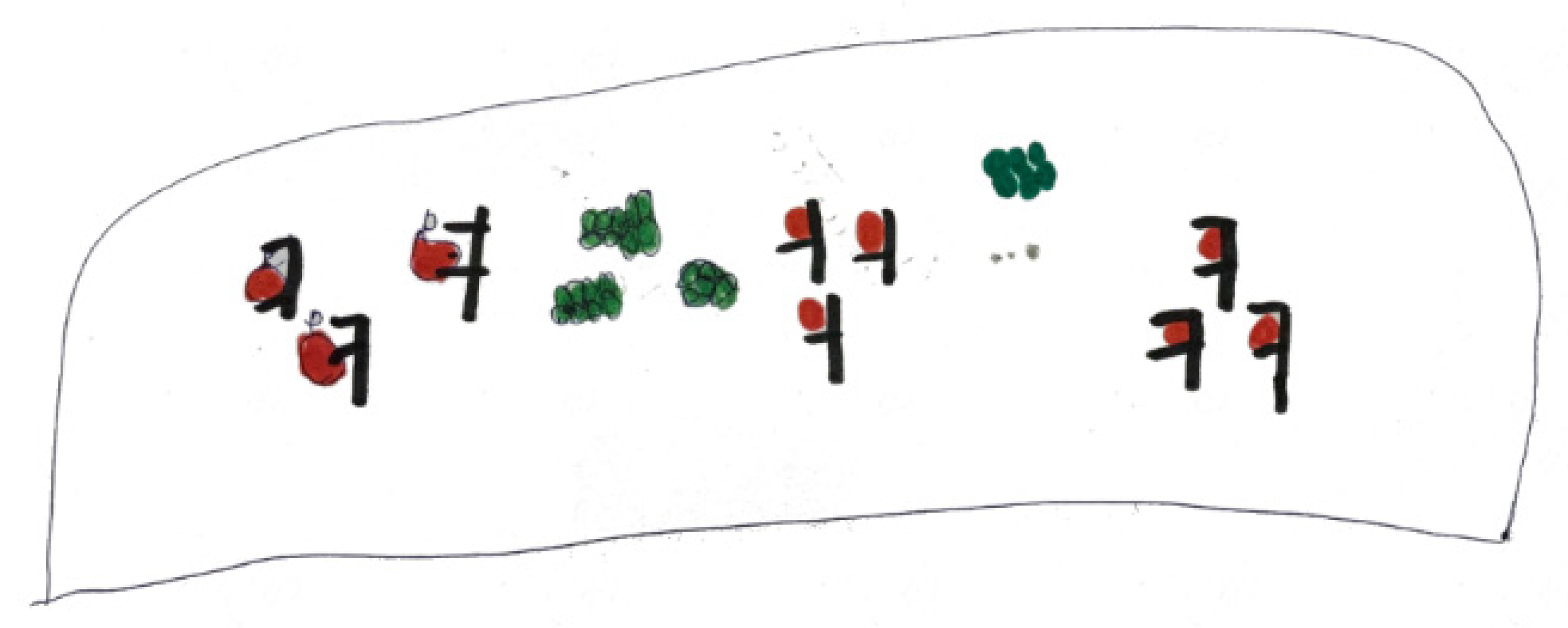
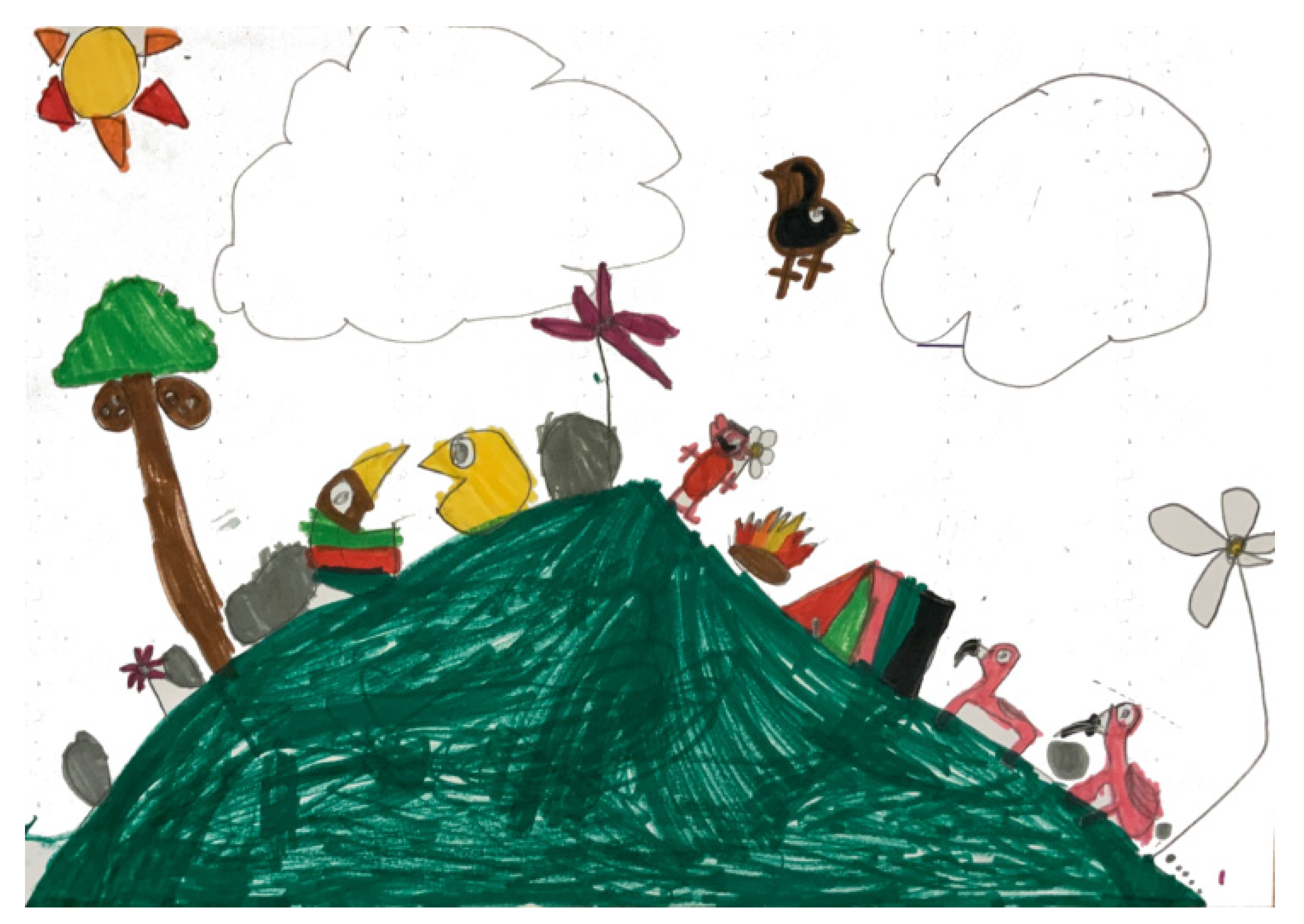
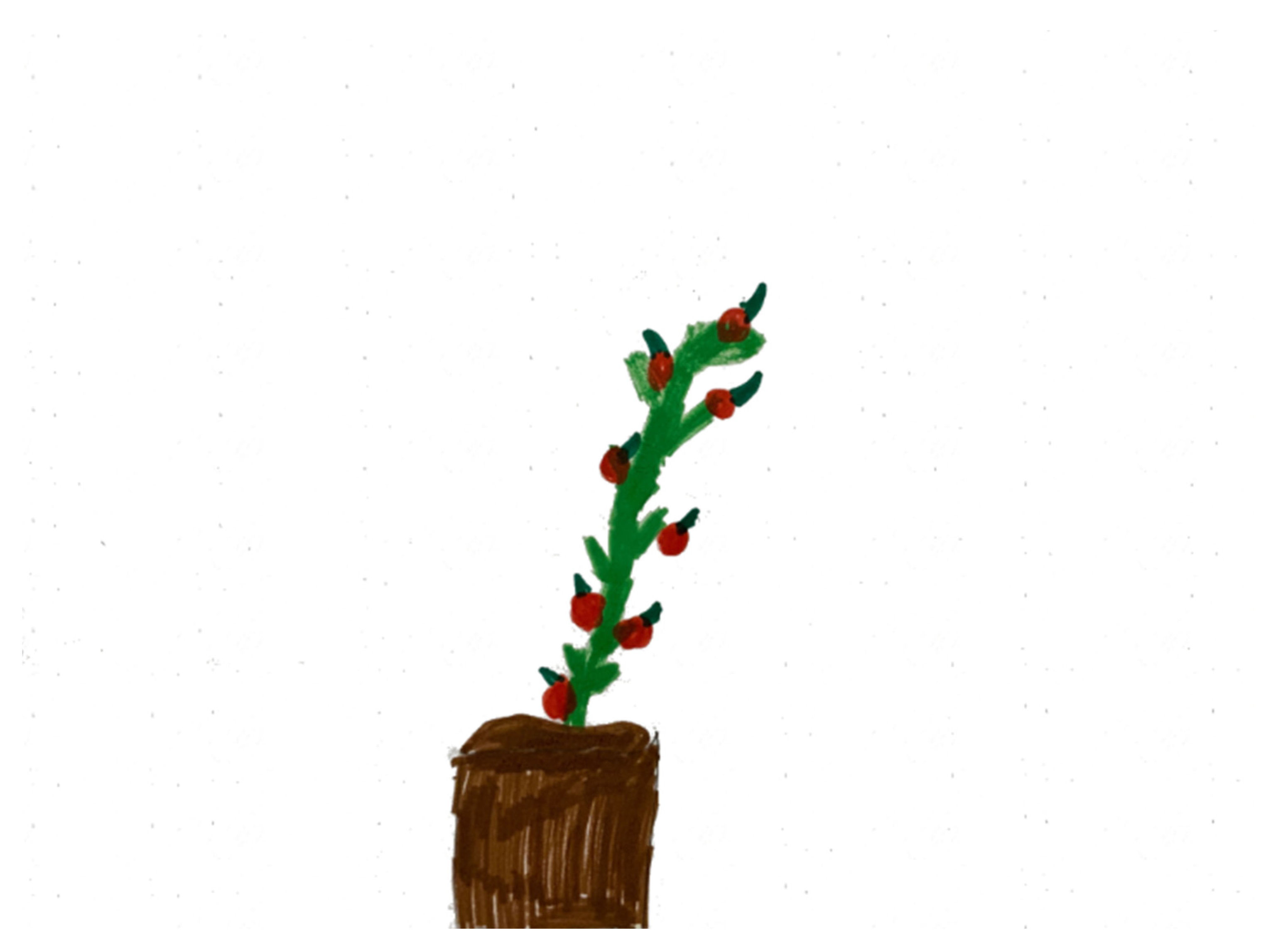
References
- D’Amore, C.; Chawla, L. Significant Life Experiences that Connect Children with Nature: A Research Review and Applications to a Family Nature Club; Cutter-Mackenzie-Knowles, A., Malone, K., Barratt Hacking, E., Eds.; Research Handbook on Childhoodnature: Assemblages of Childhood and Nature Research; Springer International Publishing: Cham, Switzerland, 2020; pp. 799–825. [Google Scholar]
- Davies, S. Let’s get gardening. Eye 2019, 21, viii–ix. [Google Scholar] [CrossRef]
- Harvey, D.J.; Montgomery, L.N.; Harvey, H.; Hall, F.; Gange, A.C.; Watling, D. Psychological benefits of a biodiversity-focussed outdoor learning program for primary school children. J. Environ. Psychol. 2020, 67, 101381. [Google Scholar] [CrossRef]
- Dankiw, K.A.; Tsiros, M.D.; Baldock, K.L.; Kumar, S. The impacts of unstructured nature play on health in early childhood development: A systematic review. PLoS ONE 2020, 15, e0229006. [Google Scholar] [CrossRef] [PubMed]
- Chawla, L. Childhood nature connection and constructive hope: A review of research on connecting with nature and coping with environmental loss. People Nat. 2020, 2, 619–642. [Google Scholar] [CrossRef]
- Hosaka, T.; Sugimoto, K.; Numata, S. Childhood experience of nature influences the willingness to coexist with biodiversity in cities. Palgrave Commun. 2017, 3, 1–8. [Google Scholar] [CrossRef]
- Beery, T.; Jørgensen, K.A. Children in nature: Sensory engagement and the experience of biodiversity. Environ. Educ. Res. 2018, 24, 13–25. [Google Scholar] [CrossRef]
- Skarstein, T.H.; Skarstein, F. Curious children and knowledgeable adults—Early childhood student-teachers’ species identification skills and their views on the importance of species knowledge. Int. J. Sci. Educ. 2020, 42, 310–328. [Google Scholar] [CrossRef]
- Fischer, L.K.; Brinkmeyer, D.; Karle, S.J.; Cremer, K.; Huttner, E.; Seebauer, M.; Nowikow, U.; Schütze, B.; Voigt, P.; Völker, S.; et al. Biodiverse edible schools: Linking healthy food, school gardens and local urban biodiversity. Urban For. Urban Green. 2019, 40, 35–43. [Google Scholar] [CrossRef]
- Benkowitz, D.; Schulz, S.; Lindemann-Matthies, P. The impact of gardening experiences on children’s intake of vegetables. J. Health Environ. Educ. 2019, 11, 1–5. [Google Scholar]
- Akoumianaki-Ioannidou, A.; Paraskevopoulou, A.T.; Tachou, V. School grounds as a resource of green space to increase child-plant contact. Urban For. Urban Green. 2016, 20, 375–386. [Google Scholar] [CrossRef]
- Harvey, D.J.; Gange, A.C.; Harvey, H. The unrealised potential of school grounds in Britain to monitor and improve biodiversity. Null 2020, 51, 306–316. [Google Scholar] [CrossRef]
- Li, D.; Chiang, Y.; Sang, H.; Sullivan, W.C. Beyond the school grounds: Links between density of tree cover in school surroundings and high school academic performance. Urban For. Urban Green. 2019, 38, 42–53. [Google Scholar] [CrossRef]
- Eugenio-Gozalbo, M.; Aragón, L.; Ortega-Cubero, I. Gardens as Science Learning Contexts across Educational Stages: Learning Assessment Based on Students’ Graphic Representations. Front. Psychol. 2020, 11, 2226. [Google Scholar] [CrossRef] [PubMed]
- Laaksoharju, T. A Children’s Garden: Connectedness to Place through Affordances: A Grounded Theory. Ph.D. Thesis, University of Helsinki, Helsinki, Finland, 2020. [Google Scholar]
- Villarroel, J.D.; Antón, A.; Zuazagoitia, D.; Nuño, T. Young children’s understanding of plant life: A study exploring rural–urban differences in their drawings. J. Biol. Educ. 2018, 52, 331–341. [Google Scholar] [CrossRef]
- Ploger, J. Bilbao City Report; LSE CASE Report 43; CASE Centre For Analysis of Social Exclusion: London, UK, 2008. [Google Scholar]
- Eusko Jaurlaritza-Gobierno Vasco Eustat: Basque Statistics Office. Available online: https://en.eustat.eus/indice.html (accessed on 25 February 2021).
- Eusko Jaurlaritza-Gobierno Vasco GeoEuskadi, Infraestructura de Datos Espaciales (IDE) de Euskadi. Available online: https://www.geo.euskadi.eus/s69-15375/es (accessed on 24 February 2021).
- The GIMP Development Team. GIMP. 2019. Available online: http://www.gimp.org/ (accessed on 28 April 2021).
- Villarroel, J.D. Young Children’s Drawings of Plant Life: A Study Concerning the Use of Colours and its Relationship with Age. J. Biol. Educ. 2016, 50, 41–53. [Google Scholar] [CrossRef]
- Villanueva, X.; Villarroel, J.D.; Antón, A. Young children’s drawings of plant world: A cohort study analysing pictorial content. J. Biol. Educ. 2019, 1–13. [Google Scholar] [CrossRef]
- Villarroel, J.D.; Merino, M.; Antón, Á. Symmetrical Motifs in Young Children’s Drawings: A Study on Their Representations of Plant Life. Symmetry 2019, 11, 26. [Google Scholar] [CrossRef]
- Villarroel, J.D.; Antón, A.; Zuazagoitia, D.; Nuño, T. A Study on the Spontaneous Representation of Animals in Young Children’s Drawings of Plant Life. Sustainability 2018, 10, 1000. [Google Scholar] [CrossRef]
- Kruskal, W.H.; Wallis, W.A. Use of ranks in one-criterion variance analysis. J. Am. Stat. Assoc. 1952, 47, 583–621. [Google Scholar] [CrossRef]
- Tomczak, M.; Tomczak, E. The need to report effect size estimates revisited. An overview of some recommended measures of effect size. Trends Sport Sci. 2014, 21, 19–25. [Google Scholar]
- Vašíčková, J.; Frömel, K.; Svozil, Z. Key competences of Czech students in PE lessons with different content. In Proceedings of the 6th FIEP European Congress, Porec, Croatia, 18–21 June 2011; pp. 496–503. [Google Scholar]
- IBM Corp. IBM SPSS Statistics for Windows, Version 26.0; IBM Corp: Armonk, NY, USA, 2019. [Google Scholar]
- R Core Team. R: A Language and Environment for Statistical Computing; R Foundation for Statistical Computing: Vienna, Austria, 2018. [Google Scholar]
- Villarroel, J.D.; Infante, G. Early understanding of the concept of living things: An examination of young children’s drawings of plant life. J. Biol. Educ. 2014, 48, 119–126. [Google Scholar] [CrossRef]
- Ahi, B. The world of plants in children’s drawings: The color preference and the effect of age and gender on these preferences. J. Baltic Sci. Educ. 2017, 16, 32–42. [Google Scholar]
- Anderson, J.L.; Ellis, J.P.; Jones, A.M. Understanding early elementary children’s conceptual knowledge of plant structure and function through drawings. CBE Life Sci. Educ. 2014, 13, 375–386. [Google Scholar] [CrossRef] [PubMed]
- Comeau, P.; Hargiss, C.L.; Norland, J.E.; Wallace, A.; Bormann, A. Analysis of Children’s Drawings to Gain Insight into Plant Blindness. Nat. Sci. Educ. 2019, 48, 1–10. [Google Scholar] [CrossRef]
- Villarroel, J.D.; Villanueva, X. A Study Regarding the Representation of the Sun in Young Children’s Spontaneous Drawings. Soc. Sci. 2017, 6, 95. [Google Scholar] [CrossRef]
- Leung, W.T.V.; Tam, T.Y.T.; Pan, W.C.; Wu, C.D.; Lung, S.C.C.; Spengler, J.D. How is environmental greenness related to students’ academic performance in English and Mathematics? Landsc. Urban Plan. 2019, 181, 118–124. [Google Scholar] [CrossRef]
- Katayama, N.; Baba, Y.G. Measuring artistic inspiration drawn from ecosystems and biodiversity: A case study of old children’s songs in Japan. Ecosyst. Serv. 2020, 43, 101116. [Google Scholar] [CrossRef]
- Villanueva, X. El pensamiento medioambiental en la infancia y su relación con el concepto de ser vivo. Ikastorratza e-Revista de Didáctica 2018, 21, 77–86. [Google Scholar] [CrossRef]
- Kuo, M.; Barnes, M.; Jordan, C. Do experiences with nature promote learning? Converging evidence of a cause-and-effect relationship. Front. Psychol. 2019, 10, 305. [Google Scholar] [CrossRef] [PubMed]
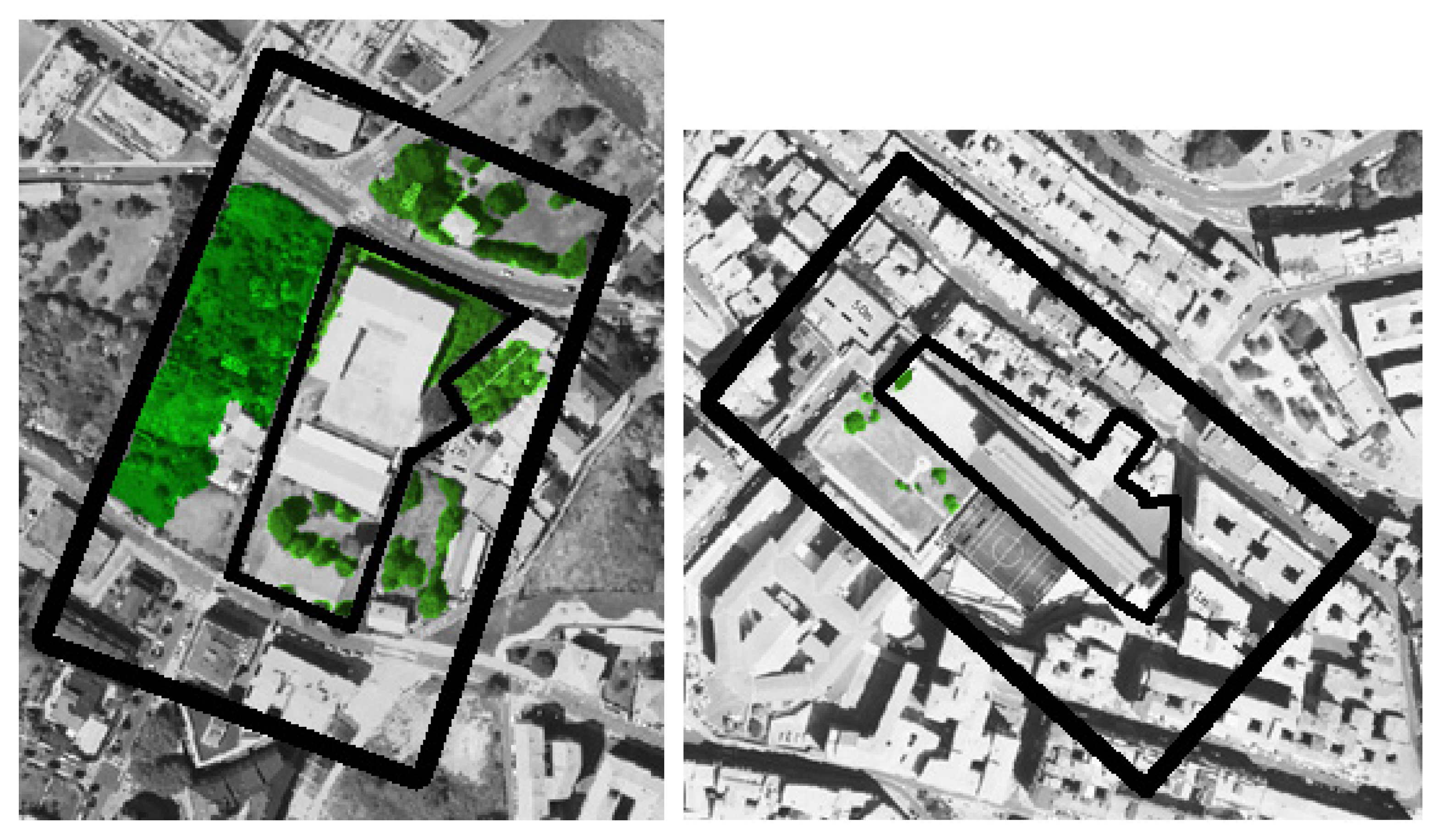
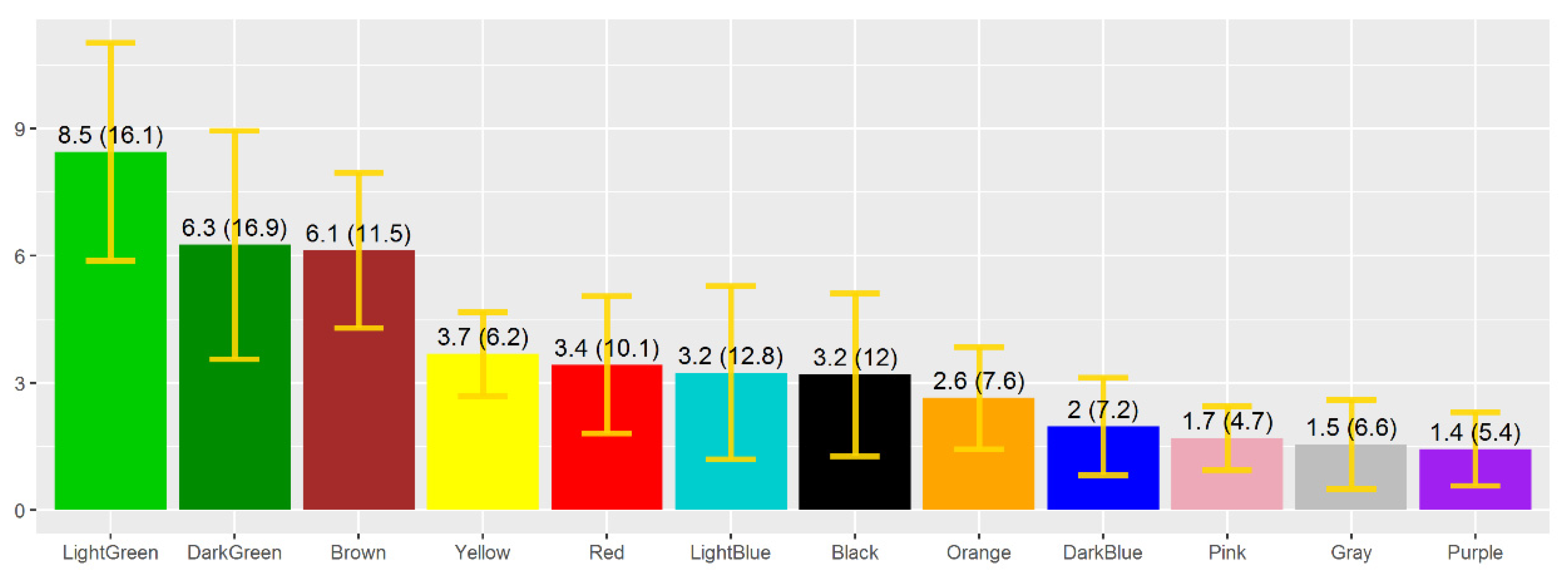
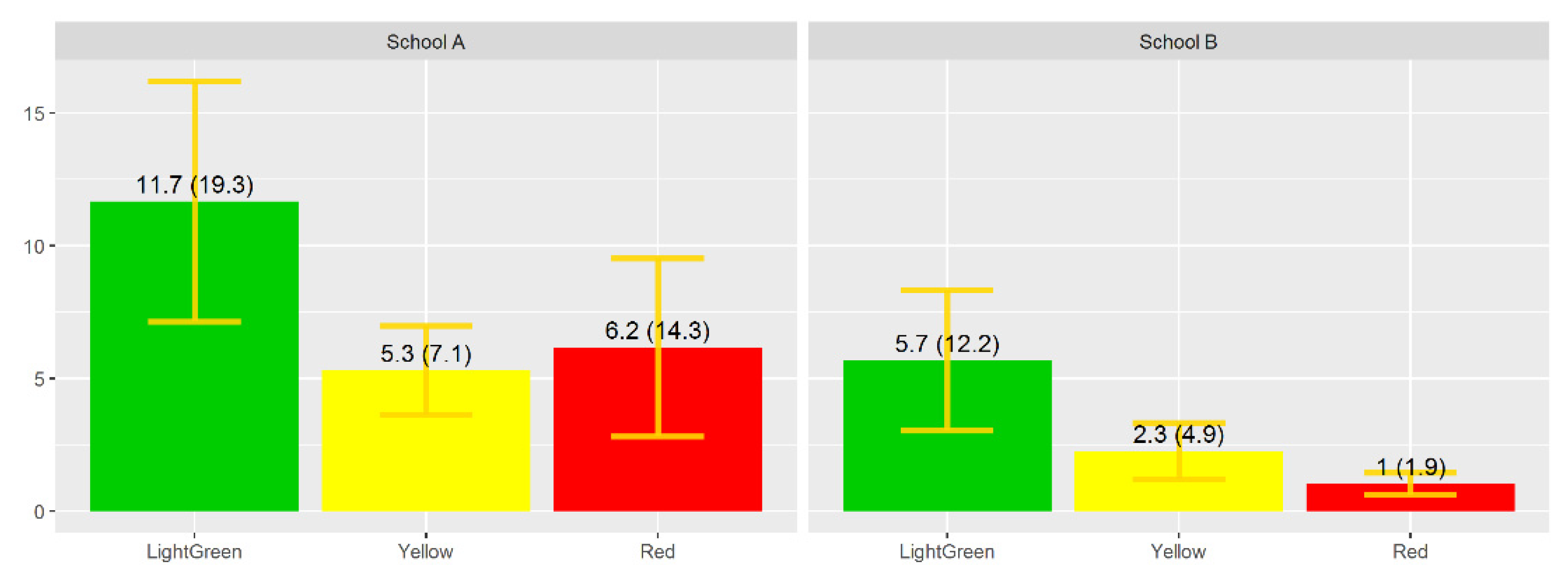
| School A | School B | |
|---|---|---|
| Municipality, country | Getxo, Spain | Bilbao, Spain |
| Total population (number of inhabitants) | 77,088 | 343,430 |
| Total area of the municipality (km2) | 11.89 | 41.60 |
| Relative area of undeveloped land (%) | 21.65 | 37.55 |
| Green area per person (km2/inhabitant) | 6.60 | 4.95 |
| Density (inhabitants/km2) | 6510.8 | 8461 |
| School A | School B | |
|---|---|---|
| Green areas inside the educational centre grounds (m2) | 1710.9 | 29.4 |
| Green areas in the area surrounding the educational centre (m2) | 11.922 | 0.0 |
| Preschool Education | Primary Education | |||
|---|---|---|---|---|
| 4–5 Years | 5–6 Years | 6–7 Years | % Girls | |
| School A | 23 | 23 | 24 | 50 |
| School B | 26 | 21 | 35 | 50 |
| Categories | % | Registered Pictorial Elements |
|---|---|---|
| Plants | 58.1 | Flowers, grass, trees, other types of plants. |
| Morphological elements of plants | 1.4 | Leaves, fruits. |
| Abiotic elements | 24.6 | Sun, clouds, rain, sky and rainbows. Soil, earth, substrate. Mountains, rivers. |
| Other living things | 4.1 | Vertebrate animals. Fungi. |
| Elements unrelated to the plant world | 11.8 | Heart, house, car, road, garbage, smoke, letters, doll, watering can, church, monster, ball. |
| School A (n = 70) | School B (n = 82) | |||||||
|---|---|---|---|---|---|---|---|---|
| Med | Mean | Sd | Min-Max | Med | Mean | Sd | Min-Max | |
| Plants | 2.0 | 1.97 | 1.97 | 1–9 | 1.0 | 1.51 | 1.24 | 0–4 |
| Total | 3.0 | 3.44 | 2.9 | 1–13 | 1.0 | 2.11 | 2.05 | 0–10 |
| School A (n = 70) | School B (n = 82) | |||||||
|---|---|---|---|---|---|---|---|---|
| Med | Mean | Sd | Min-Max | Med | Mean | Sd | Min-Max | |
| Total area | 43.4 | 59.2 | 60.2 | 0–265.7 | 7.2 | 29.6 | 48.4 | 0–275.2 |
| Light green | 0.0 | 11.7 | 19.3 | 0–28.5 | 0.0 | 5.7 | 12.2 | 0–15.0 |
| Yellow | 3.2 | 5.3 | 7.1 | 0–36.7 | 0.0 | 2.3 | 4.9 | 0–26.3 |
| Red | 1.0 | 6.2 | 14.3 | 0–84.9 | 0.0 | 1.0 | 1.9 | 0–10.3 |
Publisher’s Note: MDPI stays neutral with regard to jurisdictional claims in published maps and institutional affiliations. |
© 2021 by the authors. Licensee MDPI, Basel, Switzerland. This article is an open access article distributed under the terms and conditions of the Creative Commons Attribution (CC BY) license (https://creativecommons.org/licenses/by/4.0/).
Share and Cite
Zaballa, I.; Merino, M.; Villarroel, J.D. Children’s Pictorial Expression of Plant Life and Its Connection with School-Based Greenness. Sustainability 2021, 13, 4999. https://doi.org/10.3390/su13094999
Zaballa I, Merino M, Villarroel JD. Children’s Pictorial Expression of Plant Life and Its Connection with School-Based Greenness. Sustainability. 2021; 13(9):4999. https://doi.org/10.3390/su13094999
Chicago/Turabian StyleZaballa, Ilargi, Maria Merino, and José Domingo Villarroel. 2021. "Children’s Pictorial Expression of Plant Life and Its Connection with School-Based Greenness" Sustainability 13, no. 9: 4999. https://doi.org/10.3390/su13094999
APA StyleZaballa, I., Merino, M., & Villarroel, J. D. (2021). Children’s Pictorial Expression of Plant Life and Its Connection with School-Based Greenness. Sustainability, 13(9), 4999. https://doi.org/10.3390/su13094999






